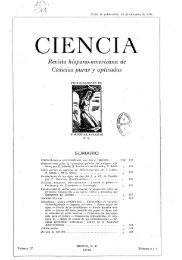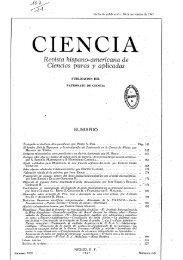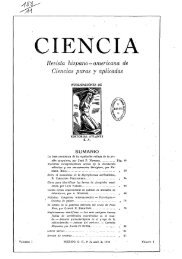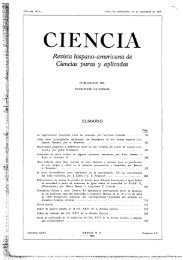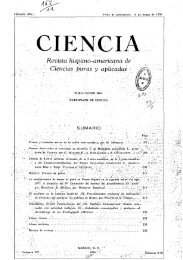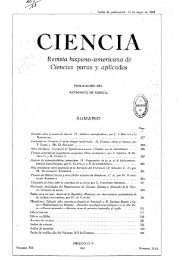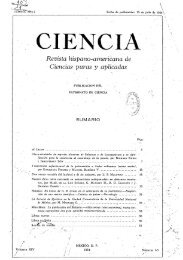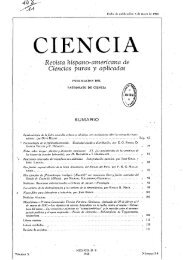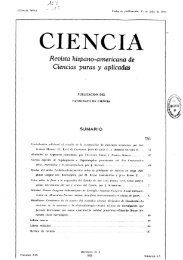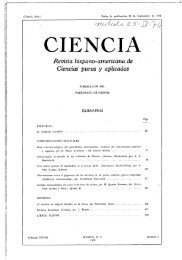Número 10-12 - Instituto de Historia de la Medicina y de la Ciencia ...
Número 10-12 - Instituto de Historia de la Medicina y de la Ciencia ...
Número 10-12 - Instituto de Historia de la Medicina y de la Ciencia ...
You also want an ePaper? Increase the reach of your titles
YUMPU automatically turns print PDFs into web optimized ePapers that Google loves.
CIENCI¿<br />
dos elementales <strong>de</strong>l mismo tipo, por ejemplo: el e"~tudio <strong>de</strong> <strong>la</strong><br />
diferencia entre <strong>la</strong>s duraciones <strong>de</strong> <strong>la</strong> mañana y <strong>de</strong> <strong>la</strong> tar<strong>de</strong>.<br />
Están bien tratados los capítulos en que hab<strong>la</strong> <strong>de</strong> <strong>la</strong> para<strong>la</strong>je,<br />
<strong>de</strong> <strong>la</strong> aberración, <strong>de</strong> <strong>la</strong> precesión y <strong>de</strong> <strong>la</strong> nutación, y<br />
muy daro el capítulo VIII en que trata <strong>de</strong> <strong>la</strong> Gravitación<br />
y <strong>de</strong> los movimientos <strong>de</strong> los cuerpos celestes.<br />
El autor termina <strong>la</strong> primera parte <strong>de</strong> <strong>la</strong> obm con dos<br />
breves capítulos <strong>de</strong>dicados, uno a <strong>la</strong> Luna, y a <strong>la</strong>l:! estrel<strong>la</strong>s<br />
el otro. A pesar <strong>de</strong> <strong>la</strong> brevedad <strong>de</strong> este último se advierte<br />
cn él <strong>la</strong> inclusión <strong>de</strong> una parte <strong>de</strong>dicada al e.'!tudio <strong>de</strong> magnitu<strong>de</strong>.'3<br />
este<strong>la</strong>re;; que no es corriente cneontmr mál:! q"ue en<br />
lo::; tratado::; <strong>de</strong> Al:itronomía Fí:-üca.<br />
Dedica el autor <strong>la</strong> 2~ parte <strong>de</strong> su obm a una brevc exposición<br />
<strong>de</strong> <strong>la</strong> teoría <strong>de</strong> <strong>la</strong> re<strong>la</strong>tividad,-y reconocemos en cl<strong>la</strong><br />
aciertos muy p<strong>la</strong>u::;ibles que avaloran <strong>la</strong> obra que coment:unos.-H.<br />
DE CASTRO.<br />
BUBNOFF, S. v., Progreso anual <strong>de</strong> <strong>la</strong> Geolog!a. Parte 4~.<br />
Geología Regional 2, 1939 Y 1940 (Geologisches Jahresberichte,<br />
IV T. Regwnale Geologie 2,1939 tl. 1:940). VI+481<br />
pp. Berlín, 1943.<br />
Los "Geologisches Jahresberichte" se refiercn al progreso<br />
anual <strong>de</strong> <strong>la</strong> geología en todos los continentes y naciones.<br />
Este tomo, llegado recientemente a México, contiene<br />
el informe re<strong>la</strong>tivo a los años 1939 y 1940, yen algunos<br />
puntos a partir <strong>de</strong> 1935. Respedo <strong>de</strong> América, He nota<br />
<strong>la</strong> falta <strong>de</strong> <strong>la</strong>s partes re<strong>la</strong>tivas a E::;tados Unido!:!, América<br />
central y Antil<strong>la</strong>s. De México !:ie ocupa F. K. G. Mullerried,<br />
<strong>de</strong>l Brasil, B. v. Freyberg y <strong>de</strong> <strong>10</strong>1; Andcs H.<br />
Gerth.~C. BOLIVAR PIELTAIN.<br />
LOON, H. W. VAN, El Pactfico (Der Pazljik). 334 pp.,<br />
ilU!:itr. Pan-VerIag. Zürich,1947.<br />
En esta obra interesante se encuentran muchos datos,<br />
algunos poco divulgados, referentes a los <strong>de</strong>scubrimientos<br />
geográficos hechos por los españoles en <strong>la</strong>s regiones australiana<br />
y papuásica. Pue<strong>de</strong>n <strong>de</strong>stacarse los siguientes:<br />
En 1526 Jorge <strong>de</strong> MeneSES llegó a Nueva Guinea.<br />
En 1546 O~tiz <strong>de</strong> Retez llegó también a estas is<strong>la</strong>s, y<br />
dió el nombre <strong>de</strong> Nueva Guinea a <strong>la</strong> is<strong>la</strong> mayor.<br />
Alvaro <strong>de</strong> Saavedra <strong>de</strong>scubrió <strong>la</strong>s is<strong>la</strong>s Hawai, y algunos<br />
al<strong>10</strong>s más tar<strong>de</strong>, en 1555, llegó también a el<strong>la</strong>s Juan<br />
Gaeta,no.<br />
Pedro Fernán<strong>de</strong>z <strong>de</strong> Quirós, el navegante <strong>de</strong> Luis' <strong>de</strong><br />
Torres, dió en 1606 el nombre <strong>de</strong> <strong>la</strong> "AuStralia <strong>de</strong>l Espíritu<br />
Santo" a una is<strong>la</strong> <strong>de</strong> <strong>la</strong>s Nuevas Hébridas, que lleva todavía<br />
el nombre <strong>de</strong> Espíritu Santo. J~uis <strong>de</strong> Torres mismo,<br />
pasó por el Estrecho que hoy lleva su nombre, entre Australia<br />
y Nueva Guinea, sin ver tierra firme."<br />
En 1642, Abel Tasman tocó tierra australiana en "Mur<br />
·<strong>de</strong>rer's Bay" , pero los indígenas le atacaron, matándole<br />
varios marineros. Van Loon da <strong>la</strong> siguiente explicación <strong>de</strong><br />
este hecho: "Los españoles hahían llegado seguramente con<br />
anterioridad a e::itas regiones <strong>de</strong>l Pacífico y combatirían<br />
con los indígenas. Esto ha quedado confirmado plenamente<br />
hace poco tiempo, al <strong>de</strong>scubrir en el puerto <strong>de</strong>Wellington,<br />
en <strong>la</strong> is<strong>la</strong> norte <strong>de</strong> N ue'va Ze<strong>la</strong>ndiá, cuando se realizaban<br />
obras <strong>de</strong> dragado, un casc¿- español <strong>de</strong>l tipo <strong>de</strong> los que se<br />
emplearon en el siglo XVI. Y cuando 50 ó 60 años <strong>de</strong>spués<br />
llegaron lo~ ho<strong>la</strong>n<strong>de</strong>ses comandados por Abel Tasman, fueron<br />
atacados por los indígenas".-}~. K. G. MULLERRIED.<br />
819<br />
PEREZ Sn,IcEo, R. y D. GALLAGHER, La geologfa <strong>de</strong> <strong>la</strong><br />
reg':ón mercurial, <strong>de</strong> El Cuarenta, Municipio <strong>de</strong> San Bernardo,<br />
Estado <strong>de</strong> Durango. Como Dir. Inv. Rec. Min. <strong>de</strong> México,<br />
Bol. 13: 21 pp., 11ám., 2 figs. México, D. F., 1947.<br />
En <strong>la</strong>s montafía.'l semiáridas <strong>de</strong>l norte <strong>de</strong>l Estado <strong>de</strong><br />
Durango existe granito con diques <strong>de</strong> diabasa, sobre los que<br />
se encuentran superpuestos conglomerados calizos y rocas<br />
, y tobas riolíticas. Como fase final <strong>de</strong>l vulcanismo hubo<br />
silicificación esporádica <strong>de</strong> todas <strong>la</strong>s rocas.<br />
En 1932 fueron <strong>de</strong>scubiertos los yacimientos <strong>de</strong> sulfuro<br />
<strong>de</strong> mercurio, al poniente <strong>de</strong> <strong>la</strong> <strong>de</strong>nominada "Vil<strong>la</strong> Cinabrio".<br />
Tales yacimientos se originaron por soluciones que<br />
contenían mercurio que ascendieron por <strong>la</strong>s fal<strong>la</strong>s, y fueron<br />
<strong>de</strong>pol:!itadas cerca '<strong>de</strong>l contacto <strong>de</strong>l granito y <strong>de</strong>l conglome-·<br />
rado calizo. Hasta 1942, <strong>la</strong> región mercurial <strong>de</strong> El Cuarenta<br />
-zona <strong>de</strong> 2 Km <strong>de</strong> longitud orientada <strong>de</strong> NO a SE-,<br />
ha producido 500 tone<strong>la</strong>das <strong>de</strong> mercurio, pero,<strong>la</strong>s minas se<br />
encuentran actualmente <strong>de</strong>stnúdas, <strong>de</strong>bido a <strong>la</strong> explotación<br />
sin método que se hizo, en que se extrajeron hasta los pi<strong>la</strong>res<br />
<strong>de</strong> sostén.-F. K. G. MULLERRIED.<br />
GONZALEZ R, J. Y D. E. WHITE, Los yacimientos <strong>de</strong> antimonio<br />
<strong>de</strong> San José, Sierra <strong>de</strong> Calorce, Es<strong>la</strong>do <strong>de</strong> San Luis<br />
Polosí. Como Dir. Inv. Rec. Min. <strong>de</strong> México, Bol. 14: 36<br />
pp., 6 láms., 5 figs., 1 tab<strong>la</strong>. México, D. F., 1947.<br />
Este boletín es traducción <strong>de</strong>l Bull. 946-E <strong>de</strong>l "U. S.<br />
Geol. Survey", <strong>de</strong> cuyo contenido s,e ha dado ya cuenta en<br />
CIENCIA.-F. K G. MULLERRIED.<br />
LIBROS RECIBIDOS<br />
En esta sección se dará cuenta <strong>de</strong> todos los libros <strong>de</strong> que<br />
::;e envíen 2 ejemp<strong>la</strong>res a <strong>la</strong> Dirección <strong>de</strong> CIENCU:<br />
DAYIDSON, M., Elements of Mathematical Astronomy<br />
with a Brief Exposition of Re<strong>la</strong>tivity. 224 pp., ilustro Hutchinson's<br />
Sc. & Techn. Publ. Londres, 1947 (15 chelines).<br />
DOIG, P., An ouiline of StelULr Astronomy: 2~_ edic. rev.,<br />
168 pp., <strong>10</strong> láms., 8 figs. Hutchinson's Sc. & Techn. Publ.<br />
Londres, 1947 (<strong>10</strong>~ chelines).<br />
RANI:IHAW, G. S., NC'ÚJ Scientific Achieuemmts. <strong>12</strong>8 pp~<br />
36 figs. ~urke Publishing Co. Ltd. Londres, 1947 (6 chelines).<br />
STEPHENS, G. A., Hormones and Vitamins, A Handbookfor<br />
Physicians and Pharmacists. XII+315 pp., 8 figs.<br />
George Newnes Ltd. Londres, 1947 (21 chelines).<br />
WHEELER, W. F., Inlermediate Biology. 3~ ed., XIV +<br />
572 pp., 304 liga., William, Heinemann Ltd. J,ondres, To<br />
,ronto, 1947.<br />
PHILLIPS, M. E. Y L. E. Cox, Manual of Botany. VI~I<br />
+384 pp., 317 figs. Univ. of Londoll Press. Londres, 1946<br />
(18 chelines).<br />
GARROD, D. A. E., Environl1lenl, To~ls & Man. 30pp'<br />
Cambr. Univ. Press. Cambridge, 1946 031 ch~lines).<br />
WUUN, D., The A,rboretulI~ and Botanical Gar<strong>de</strong>ns ot<br />
North A11lerica. Págs. 395-498, 431áms.,ilust~. Chro~. B'ot:<br />
Co. Waltham, Mass., 1947 (1,50 dóls.).<br />
SHOEMAKER, J. S., Vegetable Growing. V +506 pp., 71<br />
figs. John Wiley & Sons, Inc. Nueva York, 1947,(4,50<br />
dóls.).



